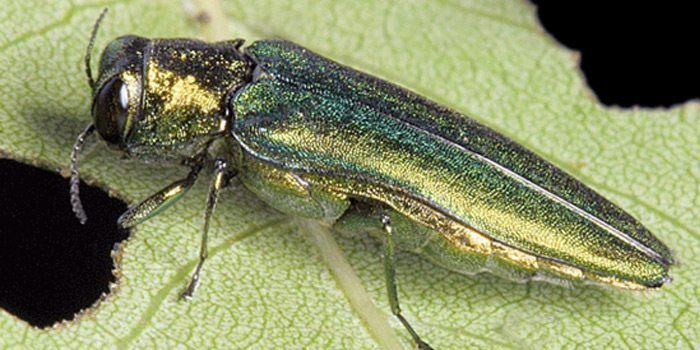There’s quite a bit more to fall tree care than raking leaves alone. Fall is an ideal time for a comprehensive tree care program. Weeding, applying fertilizer and mulch around the roots of trees, and adding compost are essential practices to keep trees healthy. However, making additional applications to trees for specific pests and diseases in your area ought also to be considered. These might include treating general stress in trees, or treating for specific pests and diseases that negatively affect the health of trees.
Treating General Stress in Trees
One of the additions I recommend for stressed trees is the addition of a phosphite product to the root zone. How can you tell if trees are suffering from stress? Stressed trees show symptoms which may be expressed as foliage that is off-color (chlorotic) or they may drop leaves prematurely. Trees that have had their roots impacted in the recent past from construction or excavation will show signs of stress. Weather may also cause trees stress: too little or too much rain can impact trees negatively, particularly in compacted or heavy soils. In wet or poorly drained soils, tree roots can be affected by root rot, such as phytophthora. Phosphite has been shown to protect against phytophthora and pythium diseases. Phosphite (PO3) is a different molecule than phosphate (PO4), the mineral component of a complete fertilizers. Phosphite is a fungicide and an elicitor of plant protective responses.
There are other fall treatments to consider for particular species of trees. Hemlock trees, ash trees, and sycamores will benefit from systemic treatments to treat tree pests and diseases specific to those trees. I discuss them below:

Hemlock Woolly Adelgid Treatment
Hemlock Woolly Adelgid (HWA), a pest of hemlock trees, emerges from a summer aestivation (dormant) period, and resumes development in the fall and winter months. HWA is a piercing-sucking insect that inserts its stylet into the xylem parenchyma (living cells of the sapwood tissues) to extract sugars and other nutrients. Though microscopic, it infests trees in large numbers that cumulatively reduce tree growth, cause the canopy to thin, and if left untreated is likely to result in tree death. Tree injection with IMA-jet (5% imidacloprid) has been documented to control HWA in hemlock for several years. Injecting trees in the fall or early spring are ideal times to protect hemlock from an HWA infestation.

Emerald Ash Borer Treatment
Emerald ash borer (EAB) is an introduced, destructive pest of our native ash trees. The larvae feed and develop under the bark of the tree, so often go unnoticed until gross symptoms occur in the tree canopy. The mining of the conductive tissues (phloem, lateral cambium and xylem) disrupts sap flow. Early signs of an infestation include foliage that is off-color (yellowed) and reduced in size. As larval populations build in the tree, leaves drop and limbs dieback. In later stages, the tree will sprout epicormic branches from buds that are still alive. Untreated, trees die in as little as four years after initial attack. Systemic injection with TREE-äge (emamectin benzoate) has been shown to be highly effective in protecting ash trees against EAB. Trees ought to be injected early, at the first signs of infestation, and may be treated spring or fall. Treatment with emamectin benzoate lasts several years, so injections do not have to applied annually.

Sycamore Anthracnose Treatment
Sycamores and London Plane trees both are susceptible to anthracnose, a disease that causes early spring defoliation of the canopy. In spring, the fungus extends its growth into the leaves, killing the leaf vascular tissue. Symptoms of leaf infection appear with browned mid-rib and leaf veins
While cool, wet springs incite defoliation, actual infection of trees with the causal organism Apiognomonia veneta is initiated in the fall, infecting the twig sapwood. Therefore, the time to treat for the disease preventatively is in fall. There are two products that may be applied, which are propiconazole (a systemic preventative fungicide) or phosphite (for example, PHOSPHO-jet). Propiconazole can be effective in limiting disease development when applied early. Phosphite has been shown to thicken the leaf cuticle to protect the tree from a secondary defoliation, and helps trees re-foliate more quickly. While neither product may prevent defoliation, they will still help with recovery. In light of these responses, I recommend treating with a phosphite product to keep trees in good health, which may be applied as a root zone drench or as a systemic tree injection treatment.
Treating trees with injections is a reliable and effective method of care, and there are multiple issues that should be addressed in fall. We have several different options for devices that can be used for tree injections. Next time, we’ll do a case study of a beloved fruit tree.
~ Signing off for now, Joe

